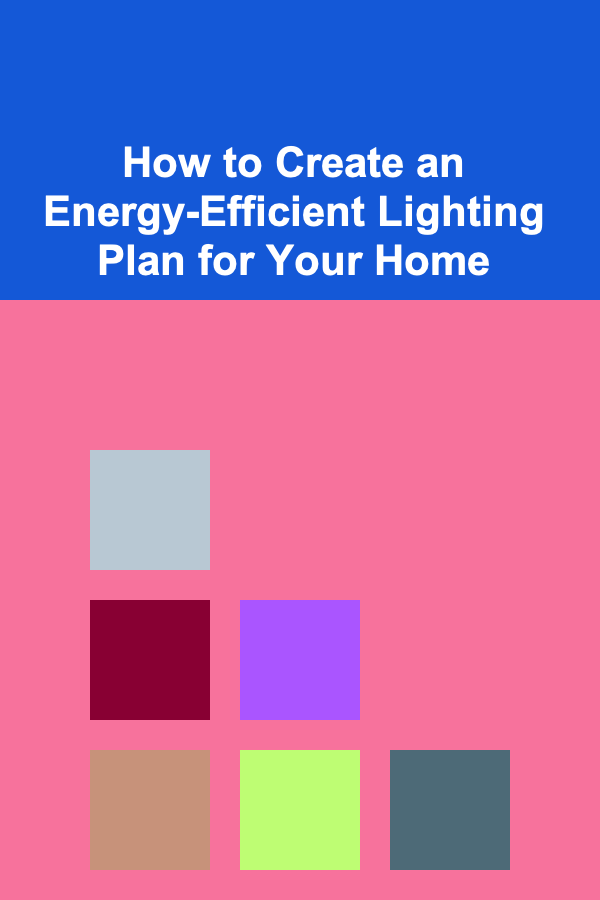
How to Create an Energy-Efficient Lighting Plan for Your Home
ebook include PDF & Audio bundle (Micro Guide)
$12.99$11.99
Limited Time Offer! Order within the next:

In today's world, energy conservation is more important than ever. With increasing concerns about climate change, environmental degradation, and rising energy costs, finding ways to reduce our energy consumption has become a priority for homeowners everywhere. One of the simplest and most effective ways to save energy in your home is through smart lighting choices. By creating an energy-efficient lighting plan, you can reduce your electricity usage, lower your utility bills, and contribute to a more sustainable environment.
In this article, we will explore how to create an energy-efficient lighting plan for your home. We will cover various strategies, from choosing energy-efficient light bulbs to optimizing your home's lighting layout. By following these steps, you can ensure that your home is well-lit, comfortable, and energy-conscious.
Understand the Importance of Energy-Efficient Lighting
Before diving into how to create an energy-efficient lighting plan, it's essential to understand why energy-efficient lighting is so important. Lighting accounts for a significant portion of energy consumption in the average home, often representing around 10-15% of total electricity use. This figure can vary depending on the size of the home, the number of light fixtures, and the types of light bulbs in use.
Energy-efficient lighting reduces energy consumption by using advanced technologies that require less electricity to produce the same amount of light. This not only saves you money but also reduces your home's overall carbon footprint, making it a simple yet impactful way to contribute to a more sustainable future.
Benefits of Energy-Efficient Lighting
- Lower Energy Bills: Energy-efficient light bulbs, such as LEDs, use significantly less energy than traditional incandescent bulbs, leading to lower electricity bills.
- Longer Lifespan: Energy-efficient bulbs last much longer than their incandescent counterparts, reducing the need for frequent replacements.
- Environmental Impact: Reducing energy consumption leads to fewer carbon emissions, which helps mitigate the effects of climate change.
- Improved Lighting Quality: Modern energy-efficient lighting options provide better and more consistent lighting, improving the overall ambiance of your home.
Choose Energy-Efficient Light Bulbs
The first step in creating an energy-efficient lighting plan for your home is choosing the right type of light bulbs. The most common types of light bulbs available today are:
1. Incandescent Bulbs
Incandescent bulbs are the traditional type of light bulb that has been in use for over 100 years. However, they are highly inefficient as they convert only about 10% of the energy they consume into light, with the rest being lost as heat. This makes them one of the least energy-efficient lighting options available.
- Pros: Inexpensive upfront cost, warm and soft light.
- Cons: High energy consumption, short lifespan.
2. Compact Fluorescent Lamps (CFLs)
CFLs are a more energy-efficient alternative to incandescent bulbs. They use around 75% less energy and last up to 10 times longer. However, CFLs contain small amounts of mercury, which requires proper disposal.
- Pros: Energy-efficient, longer lifespan than incandescent bulbs.
- Cons: Contains mercury, takes time to reach full brightness, can emit a harsh light in some cases.
3. Light Emitting Diodes (LEDs)
LEDs are the most energy-efficient lighting option available today. They use up to 90% less energy than incandescent bulbs and have a lifespan of up to 25 times longer. LEDs come in a variety of colors and brightness levels, making them a versatile choice for all types of lighting needs.
- Pros: Extremely energy-efficient, long lifespan, available in a wide range of colors and brightness levels.
- Cons: Higher initial cost, but the investment is quickly recouped due to their energy savings.
LEDs have become the go-to choice for energy-efficient lighting, and they are suitable for all areas of the home, including task lighting, ambient lighting, and accent lighting.
Consider Smart Lighting Solutions
In addition to selecting energy-efficient light bulbs, another way to optimize your lighting plan is by incorporating smart lighting solutions. Smart lighting allows you to control your lights remotely using a smartphone, tablet, or voice assistant. This technology enables you to adjust the brightness, set schedules, and even change the color of your lights.
Benefits of Smart Lighting
- Automation: With smart lighting, you can program your lights to turn on and off at specific times, ensuring that lights are only on when needed. For example, you can schedule the porch light to turn on at sunset and off at sunrise.
- Remote Control: You can control your lights from anywhere, meaning you never have to worry if you left a light on when you're away from home.
- Energy Monitoring: Some smart lighting systems can track your energy usage, giving you valuable insights into where and when you use the most energy, helping you make smarter decisions about your lighting habits.
Smart bulbs are available in both LED and CFL varieties, so you can enjoy the benefits of energy efficiency while adding convenience and automation to your home.
Take Advantage of Natural Light
One of the easiest ways to create an energy-efficient lighting plan is by maximizing the use of natural light in your home. Sunlight is free, abundant, and provides excellent illumination for any space. By strategically placing windows, using light-colored walls, and utilizing reflective surfaces, you can reduce the need for artificial lighting during the day.
Tips for Maximizing Natural Light
- Use Sheer Curtains: Heavy curtains can block sunlight, so opt for sheer curtains or blinds that allow natural light to filter into the room.
- Strategic Window Placement: Position windows where they will capture the most sunlight. South-facing windows, for example, receive the most sunlight throughout the day in northern hemisphere locations.
- Mirrors and Reflective Surfaces: Mirrors and light-colored surfaces reflect sunlight, helping to distribute natural light throughout the room.
By making the most of natural light, you can significantly reduce the amount of artificial lighting needed, saving both energy and money.
Optimize the Layout of Your Lighting
Creating an energy-efficient lighting plan is not only about the type of light bulbs you use but also about how you place and use them. By optimizing the layout and design of your lighting, you can ensure that you are using energy wisely and effectively.
Use Zoned Lighting
Instead of lighting an entire room with one bright light fixture, consider using multiple light sources in different zones. For example, in a living room, you can use task lighting (like a reading lamp) for focused activities, ambient lighting (like ceiling lights or recessed lights) for general illumination, and accent lighting (such as wall sconces or table lamps) for mood lighting.
Zoning your lighting allows you to use the right type of light for each activity and reduces the need to use bright, high-energy lights when a softer, more focused light would suffice.
Install Dimmer Switches
Dimmer switches allow you to adjust the brightness of your lights depending on the time of day or the activity you're doing. This means you can use less energy when you don't need as much light, and increase the brightness when necessary. For example, you may only need a low light level in the evening when relaxing, but a higher level of brightness during the day for tasks like reading or cooking.
Motion Sensors and Timers
Installing motion sensors in hallways, bathrooms, or other rooms where lights are often left on unnecessarily can help save energy. These sensors automatically turn lights on when they detect motion and turn them off when the room is no longer in use.
Timers are also useful for controlling outdoor lights, ensuring they are only on during the hours they are needed (e.g., dusk to dawn for security lights).
Maintenance and Regular Upgrades
An often-overlooked aspect of an energy-efficient lighting plan is regular maintenance. Over time, light fixtures can accumulate dust, reducing their brightness and efficiency. Cleaning your light fixtures regularly ensures that they are working at their best.
Additionally, as lighting technology continues to evolve, it's important to keep up with new, more efficient options. Replace older, less-efficient bulbs with newer, more energy-efficient ones when possible. For example, if you still have some incandescent bulbs in your home, it's time to replace them with LEDs.
Consider Energy-Efficient Lighting for Outdoor Spaces
Outdoor lighting can account for a significant portion of your energy use, especially if you have several fixtures around your property. To reduce outdoor lighting energy consumption, consider using energy-efficient bulbs and smart lighting solutions, just as you would indoors.
Outdoor Lighting Tips
- Use LED Lights: LEDs are perfect for outdoor lighting because they are durable and can withstand the elements. Choose energy-efficient LED floodlights, path lights, and decorative lighting to reduce energy consumption.
- Use Solar Lights: Solar-powered lights are another great option for outdoor spaces. They charge during the day and provide light at night without consuming electricity from your grid.
Conclusion
Creating an energy-efficient lighting plan for your home is an important step toward reducing your energy consumption, lowering your utility bills, and contributing to environmental sustainability. By choosing energy-efficient light bulbs, incorporating smart lighting solutions, maximizing natural light, optimizing your lighting layout, and maintaining your fixtures, you can significantly reduce your energy usage while still enjoying a well-lit and comfortable home.
As technology continues to improve and new lighting options become available, it's essential to stay informed and make updates as necessary. By taking a proactive approach to energy-efficient lighting, you'll create a more sustainable living environment that benefits both your wallet and the planet.
Reading More From Our Other Websites
- [Personal Care Tips 101] How to Meal Prep for Healthy Breakfasts
- [Skydiving Tip 101] DIY Maintenance Tips to Keep Your skydiving helmet in Peak Condition
- [Home Party Planning 101] How to Plan a Wine & Cheese Pairing Party?
- [Organization Tip 101] Why Seasonal Decluttering is Important for Space
- [Biking 101] Top 5 Trail Bikes for Different Terrain and Riding Styles
- [Home Space Saving 101] How to Design a Compact and Functional Small Bathroom
- [Personal Financial Planning 101] How to Achieve Your Financial Goals with Small Daily Changes
- [Organization Tip 101] Why You Should Use Drawer Organizers for Kitchen Utensils
- [Home Storage Solution 101] How to Keep Your Kids' Art Supplies Organized and Accessible
- [Small Business 101] Best Customer Loyalty Programs Tailored to Small Fitness Studios

How to Bake Delicious Pies and Tarts
Read More
How to Maintain a Healthy Grooming Routine for Your Pet
Read More
How to Properly Maintain Your Garden Sprinkler System Year-Round
Read More
How To Identify Marine Echinoderms
Read More
How To Explore the Origins of Grunge
Read More
How to Meal Plan for Specific Fitness Goals
Read MoreOther Products

How to Bake Delicious Pies and Tarts
Read More
How to Maintain a Healthy Grooming Routine for Your Pet
Read More
How to Properly Maintain Your Garden Sprinkler System Year-Round
Read More
How To Identify Marine Echinoderms
Read More
How To Explore the Origins of Grunge
Read More